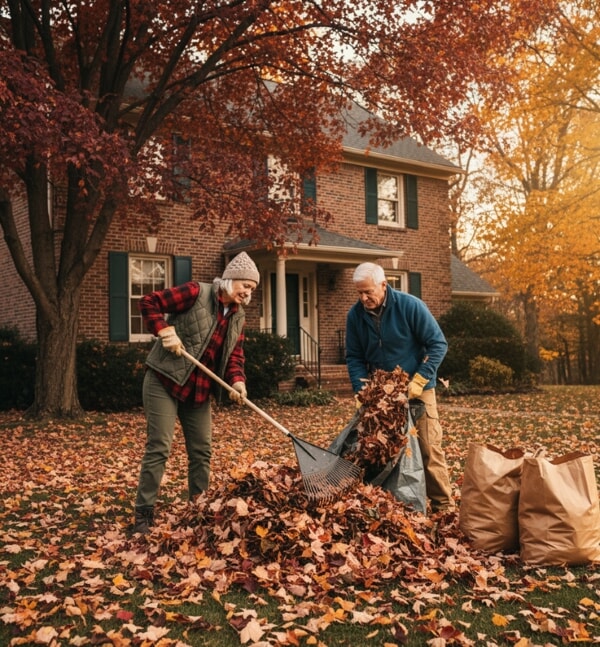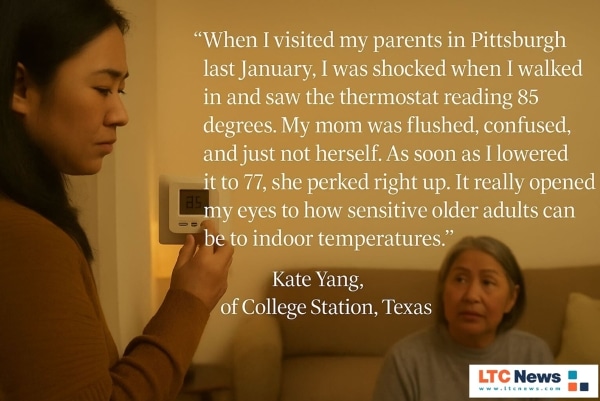How to Keep Your Aging Parent Safe at Home This Fall and Winter

Table of Contents
- Clear Outdoor Hazards Before They Become a Threat
- Keep Indoor Temperatures in a Safe Range
- When Warm Becomes Too Warm
- Prevent Falls Inside the Home
- Make the Bathroom Safer
- Address Health and Medication Safety
- Protect Against Scams and Exploitation
- Combat Social Isolation
- Plan for Home-Care Provider Delays
- A Holistic Safety Plan Supports Independence
- Reflect and Plan
You probably feel it yourself when the air turns crisp. The nights get darker earlier, walkways get slicker, and everyday routines feel just a little less certain. Fall and winter weather may look nice, but the dangers, especially for older adults, are real.
For older adults, seasonal weather changes can introduce new risks, including real hazards such as falls, health complications, social isolation, and caregiving disruptions. These all lead to a poorer quality of life if not addressed ahead of time.
A comprehensive seasonal safety plan helps reduce those risks, ensuring your loved one can age at home with dignity and confidence.
Clear Outdoor Hazards Before They Become a Threat
Start with the outside. Outdoor environments can turn hazardous quickly in the fall and winter months. Wet leaves, icy steps, uneven lighting, and winter storms create serious fall risks for aging adults, one of the most common reasons older people go to the hospital resulting in the need for long-term care.
A proactive plan makes these spaces safer and keeps your parent mobile and confident.
- Leaves and debris: Rake or blow away leaf litter promptly. Clear up patches of leaves after rain because water and leaf decomposition create a slick surface with reduced traction, easily leading to falls. Wet leaves can be as slippery as black ice. Keep gutters clear to prevent pooling water that can refreeze overnight.
- Snow and ice removal: Arrange for snow removal or ask a neighbor to help if your parent can’t do it themselves. Don't listen to our older parents about their ability to remove snow; do your own assessment. Be sure to use salt or sand on walkways, porches, and steps.
- Lighting: Install dusk-to-dawn or motion-sensor lights near entrances and along pathways to offset early darkness.
- Ramps and railings: Inspect for loose railings or uneven steps. Add ramps if climbing stairs is difficult.
- Entry safety: Place nonslip mats inside and outside. A bench or chair by the door allows your parent to rest or remove wet boots safely.
- Emergency readiness: Keep shovels, flashlights, blankets, and salt accessible. Store backup lighting and batteries in an easy-to-find location.
- Weather alerts: Set up severe weather notifications on a phone or home assistant so they’re informed of approaching storms or extreme cold.
Making the outdoor environment safer helps preserve independence and prevents avoidable injuries.
Inside, Don’t Overlook Heating System Safety
When cold weather sets in, reliable heat isn’t just a comfort; it’s essential for your parents’ health and safety. Yet heating systems are often overlooked until something goes wrong, especially by older adults living alone.
A simple annual check can help prevent serious problems, including hypothermia, respiratory issues, or emergency furnace repairs in the middle of a storm.
- Schedule a professional inspection: Have a qualified technician inspect the furnace, boiler, or heat pump before temperatures drop. These check-ups are often very affordable and help identify issues such as cracked heat exchangers, worn components, or poor airflow.
- Change filters regularly: Dirty filters reduce efficiency, drive up utility bills, and make heating less reliable. Set a reminder to replace them every one to three months during heavy use.
- Check for carbon monoxide: Install working carbon monoxide detectors near bedrooms and living spaces. Aging furnaces are a common source of CO leaks, which can be dangerous and difficult to detect.
- Test backup heat sources: If your parent uses space heaters, ensure they have auto shut-off features and are placed away from curtains, bedding, or flammable materials.
- Monitor temperature settings: Some older adults lower the thermostat to save money, but may not realize how quickly a home can become dangerously cold. Other older adults tend to raise the thermostat too warm. Encourage them to keep the thermostat at or above 68 °F, as recommended by the U.S. National Institute on Aging, but never too warm.
- Have a storm plan: If the power goes out, make sure there’s a safe alternative heat source, warm clothing, blankets, and a communication plan to check in.
Experts say that some older adults may not notice indoor temperatures dropping as quickly as younger people do, and that can increase the risk of hypothermia or other health issues.
A properly maintained heating system not only keeps your parent warm—it can prevent emergencies that threaten their health and independence.
Keep Indoor Temperatures in a Safe Range
Maintaining the heating system is step one; maintaining the thermostat may be more challenging. Older adults may feel more comfortable keeping their homes warmer than younger people would, but experts warn that there’s a sweet spot to shoot for. Too cold or too warm can both increase health risks.
Most experts recommend keeping the thermostat set between a safe range of 68 °F to 78 °F (18–26 °C), which can work depending on personal comfort, insulation, and health conditions.
A study on cognitive performance found that the optimal indoor temperature for older adults is between 68 °F and 75 °F, and deviations of about 7 °F above or below that range doubled the likelihood of attention problems.
When Warm Becomes Too Warm
Turning up the thermostat too high can also be dangerous. Temperatures above 80 °F (27 °C) can quickly become unsafe for older adults.
When indoor temperatures reach 88 °F (31 °C) or higher, the risk of heat-related illness rises sharply, especially for those with chronic health conditions or reduced mobility.

Share your experiences and insights on aging, caregiving, health, retirement, and long-term care with LTC News - Contact LTC News.
Prevent Falls Inside the Home
Falls remain the leading cause of injury among older adults. A few simple adjustments can dramatically reduce risk inside the home:
- Floors: Remove or secure throw rugs, tape down cords, and clear pathways.
- Stairs: Install sturdy handrails on both sides; consider nonslip treads.
- Lighting: Place nightlights in hallways, bathrooms, and bedrooms.
- Furniture: Rearrange for wide, clear walkways that accommodate mobility aids.
- Main-floor living: If mobility is declining, consider moving the bedroom downstairs. Approach gently—many older adults see this as a loss of independence, even when it supports independence.
Make the Bathroom Safer
The bathroom is one of the highest-risk areas for falls. Slick surfaces, tight spaces, and steam can lead to serious injury.
- Grab bars: Install near toilets and showers.
- Non-slip surfaces: Add mats or decals to bathtubs and showers.
- Raised toilet seats: Make sitting and standing easier.
- Water temperature: Set the heater to 120°F or lower to prevent scalding.
A single bathroom fall can result in hospitalization or trigger a transition to assisted living or nursing care.
Address Health and Medication Safety
Cold weather doesn’t just increase fall risk—it can also affect underlying health conditions, disrupt medication schedules, and increase respiratory illness risk.
- Medication management: Use weekly organizers, phone reminders, or pharmacy-synchronized refills.
- Temperature sensitivity: Many older adults don’t feel cold as much as younger adults do. The U.S. National Institute on Aging recommends keeping the home at least 68°F.
- Vaccinations: Encourage flu and COVID boosters as appropriate.
- Watch for subtle changes: Confusion, fatigue, or appetite changes can signal infection or medication issues.
- Review medications: Some prescriptions increase fall risk. Review them annually with a physician or pharmacist.
- Schedule checkups: Do these before winter storms make travel harder.
Protect Against Scams and Exploitation
Winter brings an increase in fraud targeting older adults who are home more often. Scammers use fear, urgency, and seasonal context to manipulate their targets.
- Utility scams: Real utility companies never demand payment through gift cards or wire transfers.
- Charity fraud: Verify charities through Charity Navigator or IRS databases before donating.
- Home-repair fraud: Decline unsolicited snow removal or furnace repair offers. Get bids from trusted providers.
- Phone and phishing scams: Teach your parent to hang up and call the official number directly.
- Legal safeguards: Consider naming a trusted contact or limited power of attorney to prevent financial exploitation.
- Door security: A doorbell camera or peephole improves safety after dark.
Scammers use fear and urgency to pressure people into acting fast. The best defense is to slow down, verify, and talk to someone you trust. — Kathy Stokes, AARP Fraud Prevention Programs Director.
Combat Social Isolation
Shorter days, colder temperatures, and unsafe travel can leave older adults isolated. According to the U.S. Surgeon General’s 2023 advisory, chronic loneliness carries a health impact comparable to smoking 15 cigarettes a day.
- Regular contact: Daily or weekly calls, texts, or video chats make a difference.
- Community programs: Senior centers, libraries, and faith groups often offer winter activities.
- Buddy system: Pair your parent with a neighbor or friend to check in during storms.
- Technology: Tablets and voice assistants can simplify connections.
- Home visits: Family, friends, or paid companions can help fill social gaps.
- Holiday traditions: Involving your parent in seasonal activities fosters connection.
Plan for Home-Care Provider Delays
Even the best care plans can be disrupted when winter weather strikes. When caregivers or aides can’t get to your parent’s home, your backup plan becomes critical.
- Ask about weather policies: Many home-care agencies have storm protocols, including pre-positioned staff or tele-check-ins.
- Emergency kits: Keep at least three days of medications, non-perishable food, water, blankets, flashlights, and contact lists.
- Remote monitoring: Phone or video calls can replace brief in-person visits.
- Backup caregivers: Identify neighbors, friends, or family who can step in.
- Clear communication: Ensure the agency provides timely updates on delays.
- Power and heat: Ensure backup plans if the home loses heat or power.
- Transport contingency: If care includes rides to appointments, plan for alternatives such as telehealth or family assistance.
Being prepared for poor winter weather is vital, since closed roads and stores mean no medications, food, or supplies during a winter storm.
Tip: Use the LTC News Caregiver Directory to find qualified caregivers, and be sure to ask about what happens in bad winter weather. You can also use the LTC News Cost of Care Calculator to estimate the costs for long-term care services in your parents' ZIP code.
A Holistic Safety Plan Supports Independence
A good winter safety strategy goes beyond fall prevention. It safeguards your parents’ health, financial security, and emotional well-being—even during storms or care interruptions.
- Secure outdoor areas.
- Fall-proof the home.
- Prioritize health and medication safety.
- Protect against scams.
- Reduce isolation.
- Plan for care disruptions.
- Maximize LTC Insurance benefits.
You can’t control the weather, but you can control how prepared your family is for it.
Reflect and Plan
What single change could make your parent’s home safer right now? A grab bar, a snow-removal plan, or a backup caregiver can mean the difference between stability and crisis.
Winter safety planning is a powerful way to protect both health and independence and to give your family peace of mind.
As your parents age, don't hesitate to get them professional extended care, either at home or in a quality long-term care facility like assisted living. Be sure to ask if they have a Long-Term Care Insurance policy. If they do, be sure to use the benefits.
Now is also a good time to think about how your family would address your future aging and long-term care needs. Most people acquire an LTC policy between the ages of 46 and 67.


